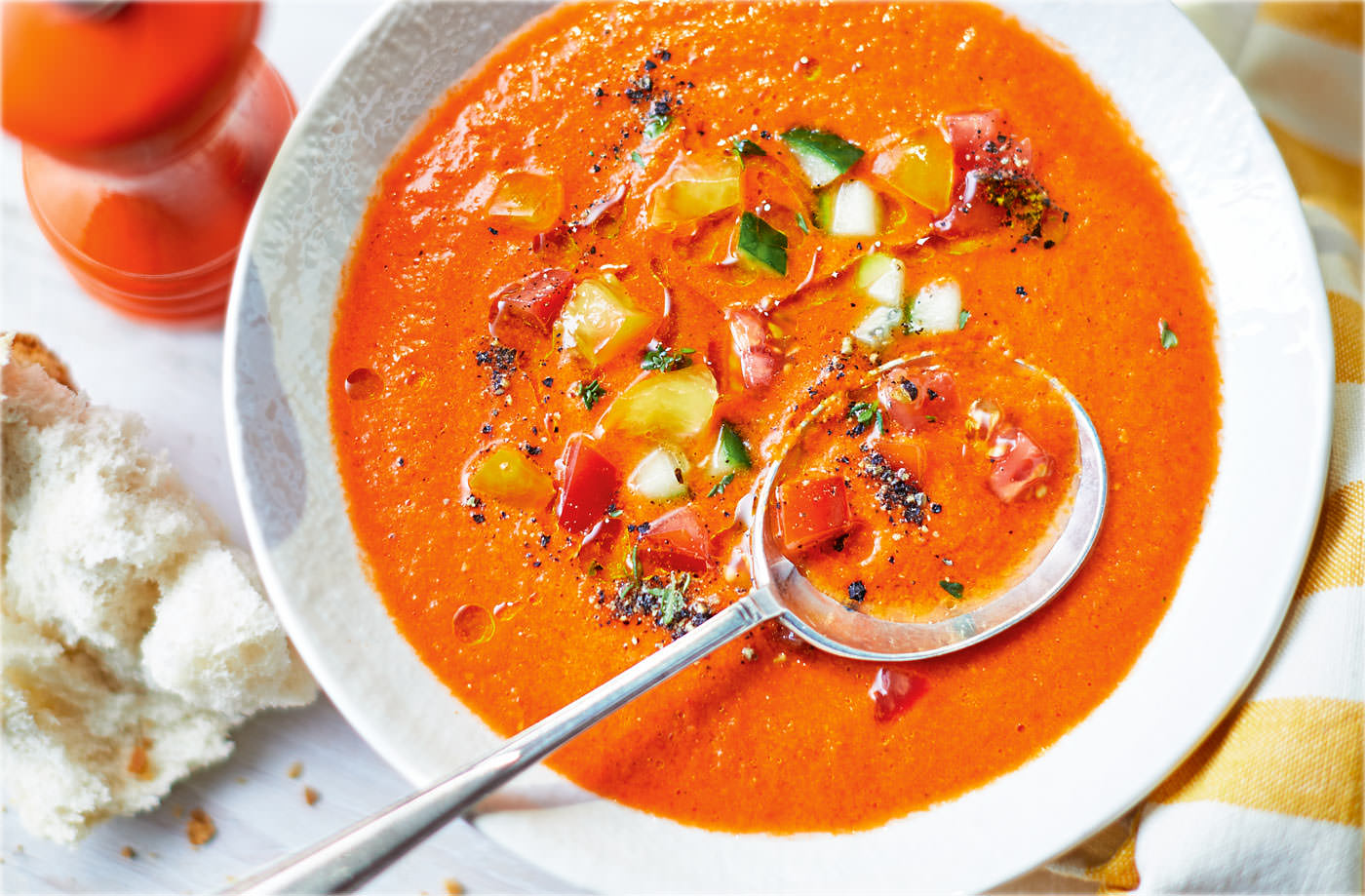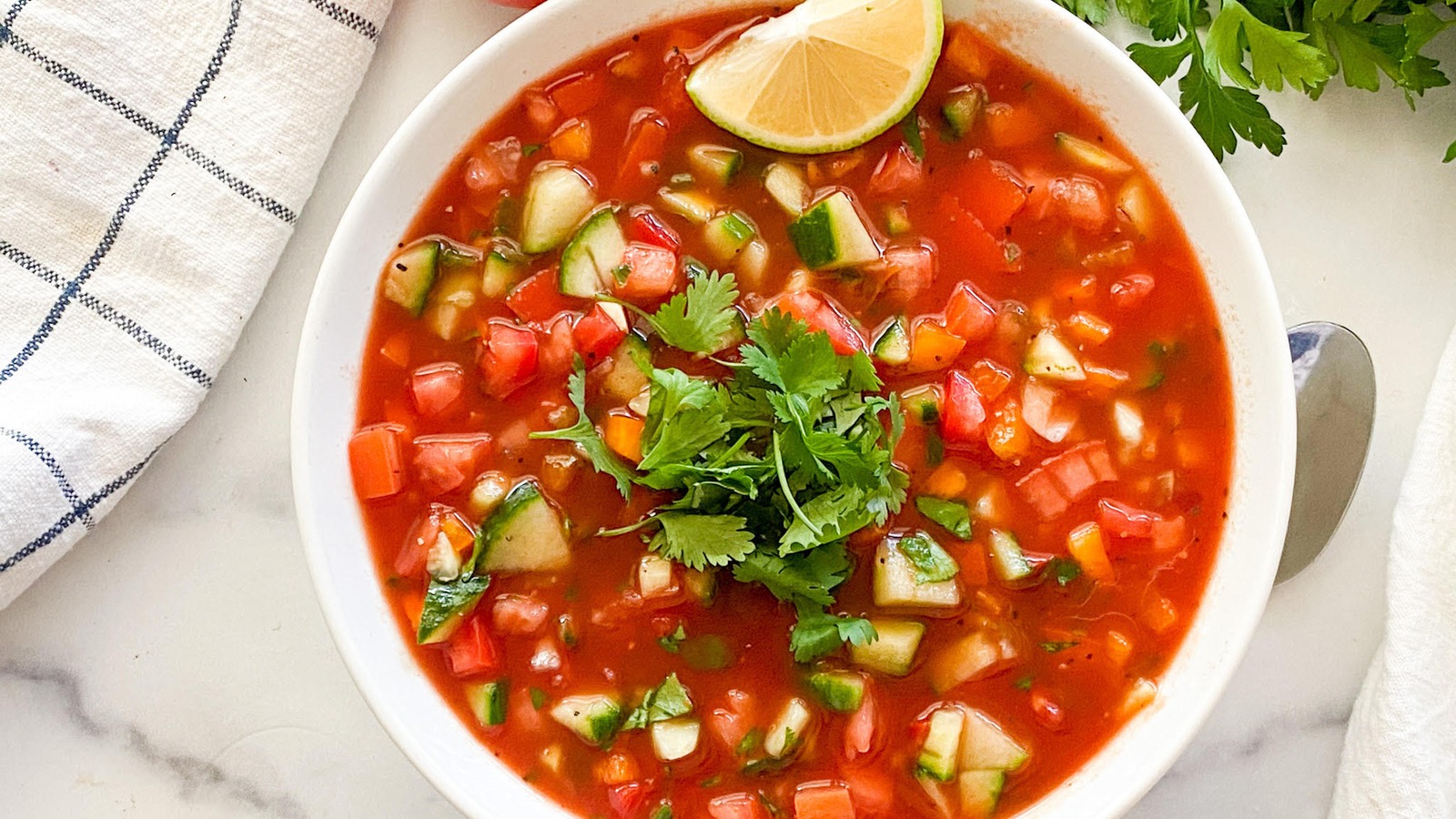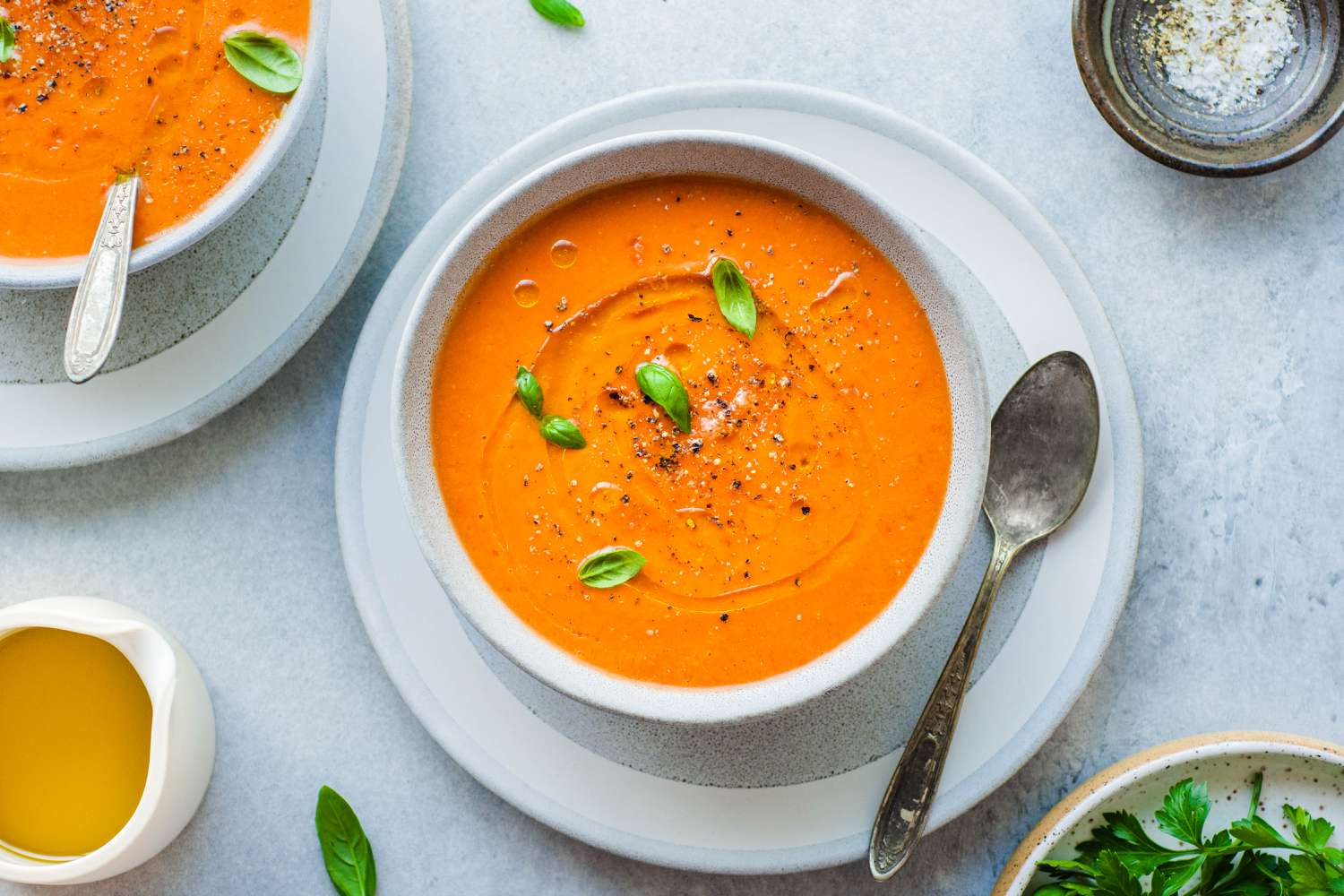In This Article
ToggleGazpacho is a traditional Spanish cold soup that perfectly captures the essence of summer with its refreshing, vibrant flavors. Made with fresh, ripe vegetables, Gazpacho is not only a culinary delight but also a nutritious and revitalizing dish. In this article, we will explore the rich history, health benefits, and various ways to enjoy Gazpacho, celebrating this classic Spanish soup in all its glory.
The Origins of Gazpacho

Gazpacho has a long and storied history, dating back to ancient times. The origins of Gazpacho can be traced to the southern region of Andalusia in Spain, where it was originally a humble peasant dish. Early versions of Gazpacho were made with stale bread, garlic, olive oil, vinegar, and water. Over time, as tomatoes and peppers were introduced to Europe from the New World, these ingredients became integral to the recipe, giving Gazpacho its distinctive red color and vibrant flavor.
Gazpacho quickly gained popularity across Spain and beyond, becoming a symbol of Spanish cuisine. Today, it is enjoyed worldwide as a refreshing and healthy summer soup.
The Health Benefits of Gazpacho
Gazpacho is not only delicious but also packed with health benefits. Here are some of the key nutritional advantages of this classic Spanish soup:
- Rich in Vitamins and Antioxidants: Gazpacho is made with fresh vegetables like tomatoes, peppers, cucumbers, and onions, all of which are rich in vitamins A, C, and E. These vitamins are powerful antioxidants that help protect the body against free radicals and boost the immune system.
- Hydrating and Low in Calories: Because Gazpacho is a cold soup made primarily of water-rich vegetables, it is incredibly hydrating and low in calories. This makes it an ideal dish for hot summer days when staying hydrated is essential.
- High in Fiber: The vegetables in Gazpacho provide a good amount of dietary fiber, which aids in digestion, helps regulate blood sugar levels, and promotes a feeling of fullness.
- Heart-Healthy: The olive oil used in Gazpacho is a source of healthy monounsaturated fats, which are beneficial for heart health. Olive oil also contains anti-inflammatory properties that can help reduce the risk of chronic diseases.
Crafting the Perfect Gazpacho

Creating the perfect Gazpacho involves using the freshest ingredients and blending them to achieve a smooth, flavorful consistency. Here’s a classic recipe to help you make this refreshing soup at home:
Ingredients:
- 6 ripe tomatoes, chopped
- 1 cucumber, peeled and chopped
- 1 red bell pepper, chopped
- 1 small red onion, chopped
- 2 cloves of garlic, minced
- 3 cups of cold water
- 1/4 cup of extra virgin olive oil
- 2 tablespoons of red wine vinegar
- Salt and pepper to taste
- Fresh basil or parsley for garnish
Instructions:
- Prepare the Vegetables: Wash and chop the tomatoes, cucumber, red bell pepper, and red onion. Mince the garlic cloves.
- Blend the Ingredients: In a blender, combine the chopped vegetables, garlic, cold water, olive oil, and red wine vinegar. Blend until smooth. Depending on the size of your blender, you may need to do this in batches.
- Season and Chill: Season the Gazpacho with salt and pepper to taste. Transfer the soup to a large bowl or pitcher and refrigerate for at least 2 hours to allow the flavors to meld and the soup to chill thoroughly.
- Serve and Enjoy: Stir the Gazpacho well before serving. Pour into bowls or glasses and garnish with fresh basil or parsley. Enjoy the refreshing, vibrant flavors of this classic Spanish soup.
Variations on a Classic: Gazpacho Twists

While the traditional tomato-based Gazpacho is beloved by many, there are several delicious variations to explore. Here are a few creative twists on the classic recipe:
1. White Gazpacho (Ajo Blanco): This variation originates from Andalusia and is made with bread, almonds, garlic, olive oil, and grapes. Ajo Blanco has a creamy, nutty flavor and is often garnished with green grapes and a drizzle of olive oil.
2. Green Gazpacho: Green Gazpacho is made with green vegetables like cucumbers, green bell peppers, avocados, and herbs such as cilantro and parsley. This version is vibrant and refreshing, with a slightly different flavor profile than the classic red Gazpacho.
3. Watermelon Gazpacho: For a sweet and savory twist, try Watermelon Gazpacho. This version combines tomatoes, watermelon, cucumber, and mint, creating a delightful balance of flavors. It’s perfect for a hot summer day.
4. Spicy Gazpacho: If you like a bit of heat, add some spice to your Gazpacho with jalapeños or red pepper flakes. The spicy kick pairs well with the cool, refreshing base of the soup.
Serving Suggestions: Pairings and Accompaniments
Gazpacho is a versatile dish that can be enjoyed in various ways. Here are some serving suggestions and accompaniments to enhance your Gazpacho experience:
1. Crusty Bread: Serve Gazpacho with slices of crusty bread or a baguette. The bread can be used to scoop up the soup or enjoyed on the side.
2. Tapas: Pair Gazpacho with a selection of Spanish tapas such as olives, manchego cheese, jamón ibérico, and patatas bravas. This creates a delightful and varied meal.
3. Salad: A light salad with fresh greens, tomatoes, and a tangy vinaigrette complements the flavors of Gazpacho. Consider a simple arugula salad or a mixed vegetable salad.
4. Garnishes: Enhance your Gazpacho with a variety of garnishes. Some popular options include diced cucumber, chopped bell pepper, croutons, and a drizzle of extra virgin olive oil.
Gazpacho in Culinary Traditions Around the World

While Gazpacho is quintessentially Spanish, its concept of cold, refreshing vegetable soups can be found in various culinary traditions around the world. Here are a few international takes on similar dishes:
1. Cucumber Soup (Eastern Europe): In Eastern Europe, cold cucumber soup is a popular summer dish. Made with yogurt, cucumbers, dill, and garlic, it is light, refreshing, and tangy.
2. Tarator (Bulgaria): Tarator is a traditional Bulgarian cold soup made with yogurt, cucumbers, garlic, dill, and walnuts. It is often served as a starter or a refreshing side dish.
3. Okroshka (Russia): Okroshka is a Russian cold soup made with kvass (a fermented beverage), cucumbers, radishes, boiled potatoes, and eggs. It is a hearty and satisfying dish perfect for hot days.
4. Vichyssoise (France): Vichyssoise is a classic French cold soup made with leeks, potatoes, onions, chicken broth, and cream. It is typically pureed until smooth and served chilled.
The Joy of Gazpacho: A Personal Connection
For many, Gazpacho is more than just a dish; it is a source of joy and nostalgia. It evokes memories of family gatherings, summer vacations, and leisurely meals in the sun. The act of making and sharing Gazpacho brings people together, creating a sense of community and connection.
Gazpacho is also a celebration of the bounty of summer produce. Using fresh, ripe vegetables at their peak of flavor makes the dish truly special. The vibrant colors and bold flavors of Gazpacho are a testament to the beauty and abundance of nature.
Conclusion: Embracing the Delight of Gazpacho

Gazpacho is a timeless classic that continues to delight taste buds around the world. Its refreshing, vibrant flavors and endless versatility make it a beloved dish for people of all ages. Whether you stick to the traditional wdbos recipe or explore creative variations, Gazpacho offers a delightful culinary experience that is both satisfying and revitalizing. So, the next time you’re looking for a refreshing meal, reach for the ingredients to make Gazpacho and savor the fresh, vibrant flavors of this classic Spanish soup.





